Bài giảng Introduction to Software Engineering - Week 8: UI Design - Nguyễn Thị Minh Tuyền
User interface
£ User interfaces should be designed to match the
skills, experience and expectations of its
anticipated users.
£ System users often judge a system by its
interface rather than its functionality.
£ A poorly designed interface
p Can cause a user to make catastrophic errors.
p Is the reason why so many software systems are never
used.
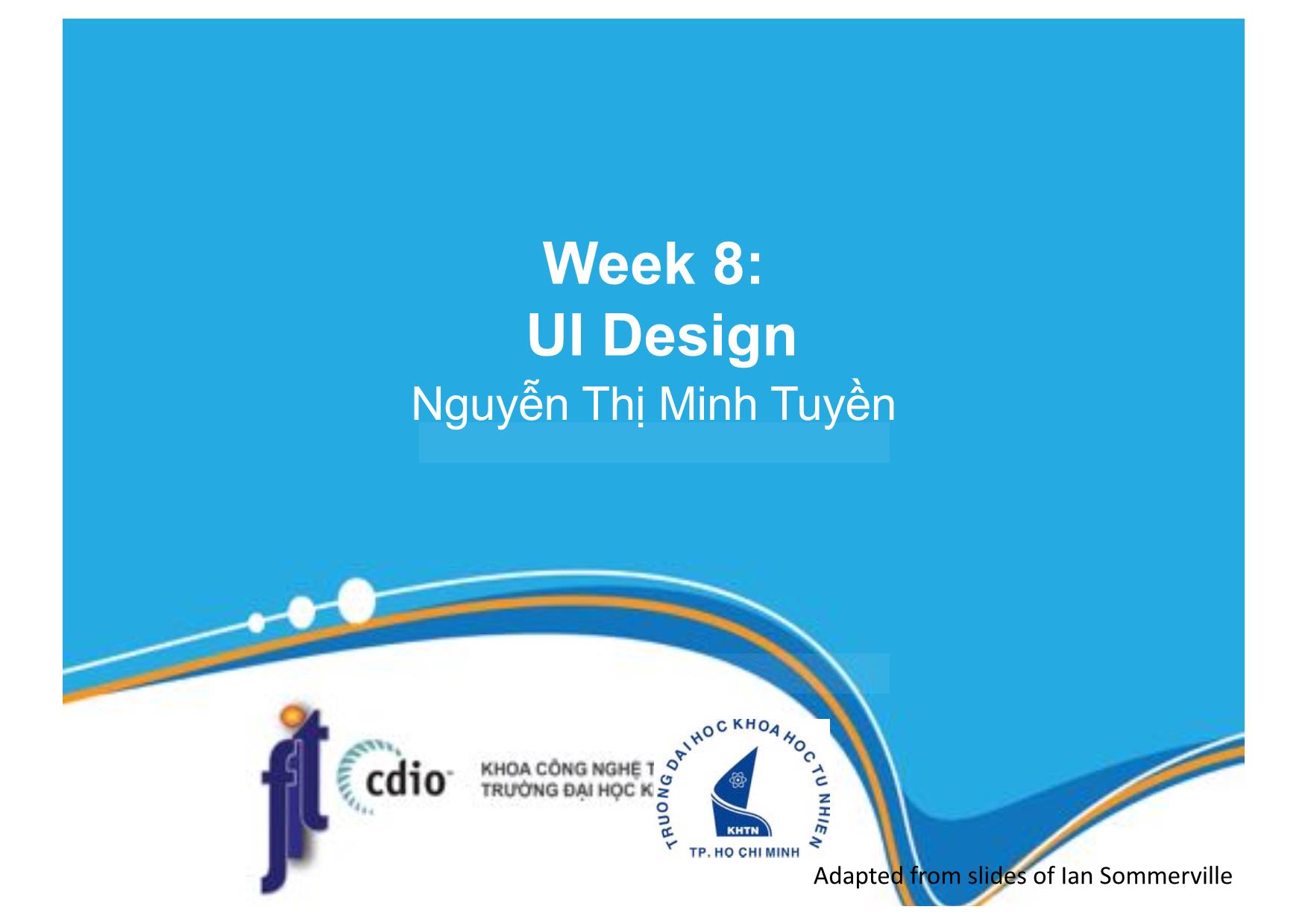
Trang 1
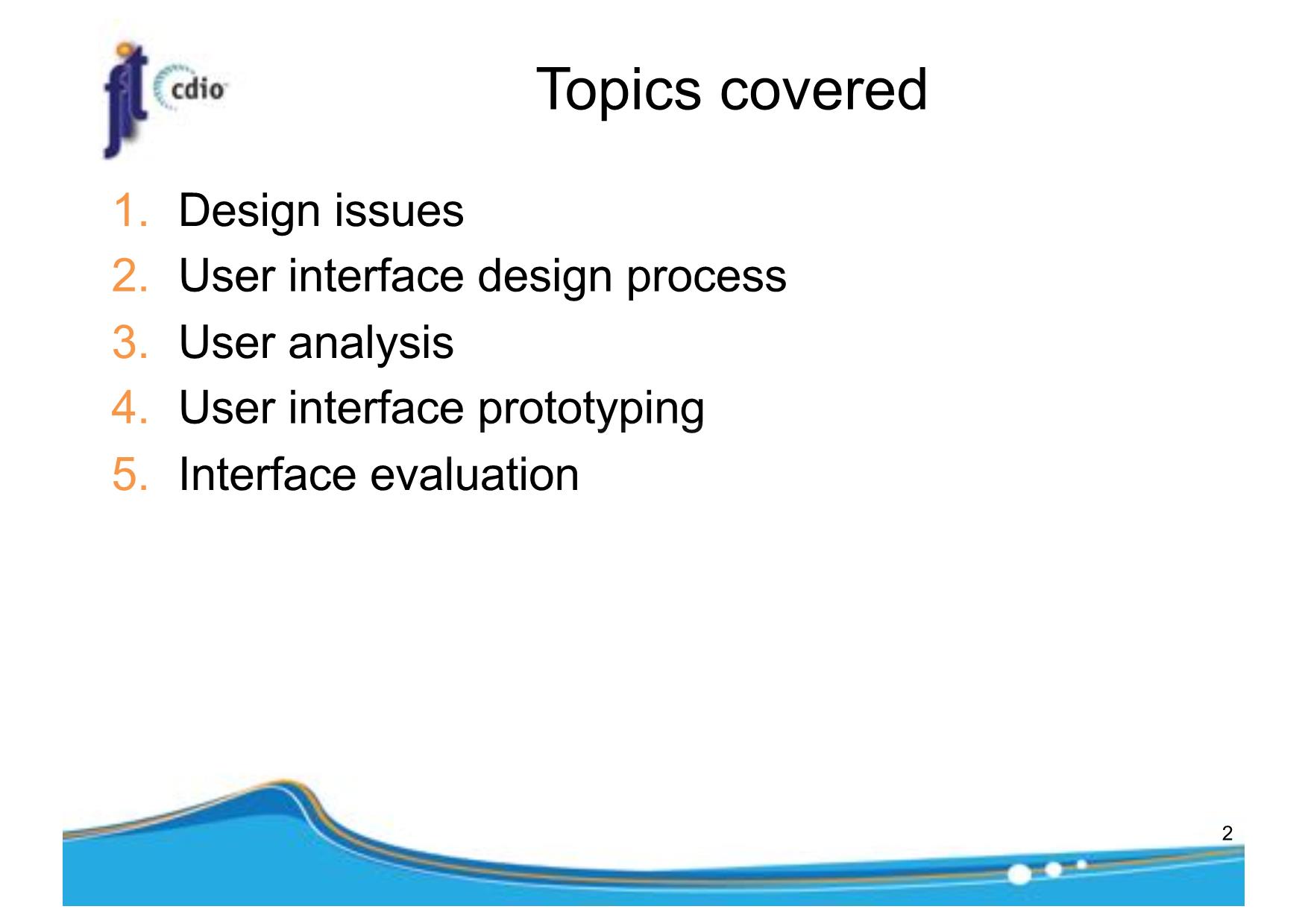
Trang 2
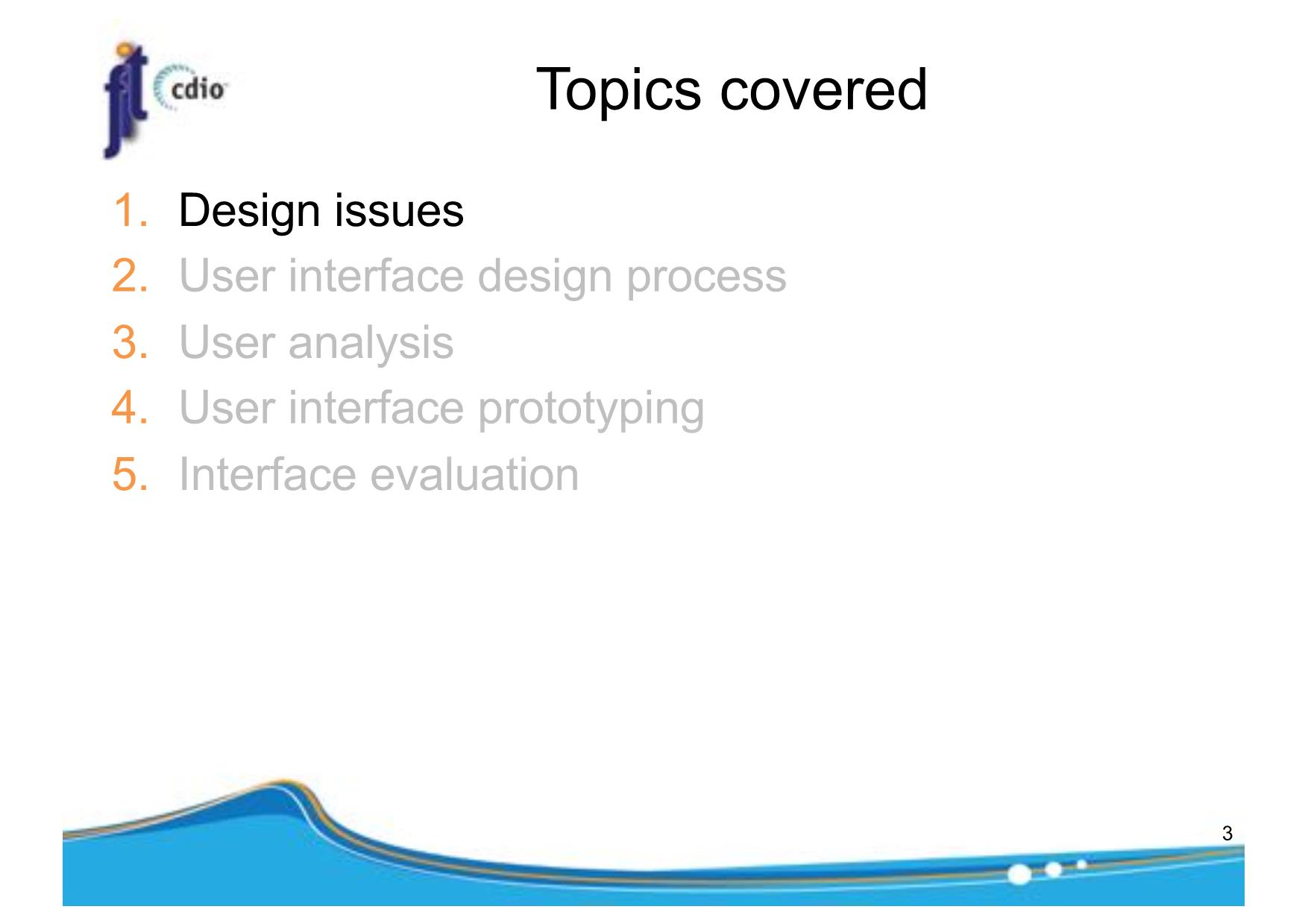
Trang 3
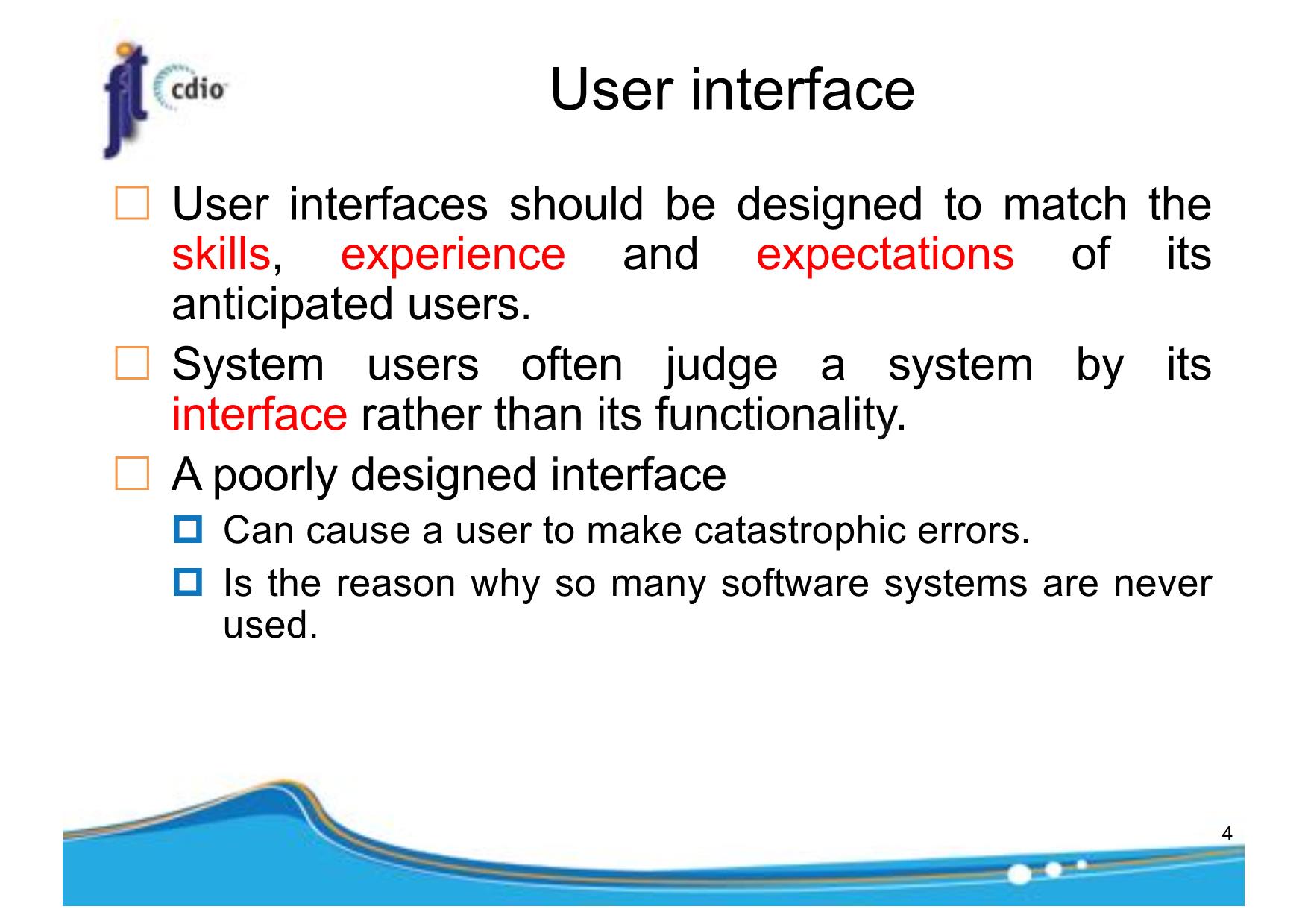
Trang 4
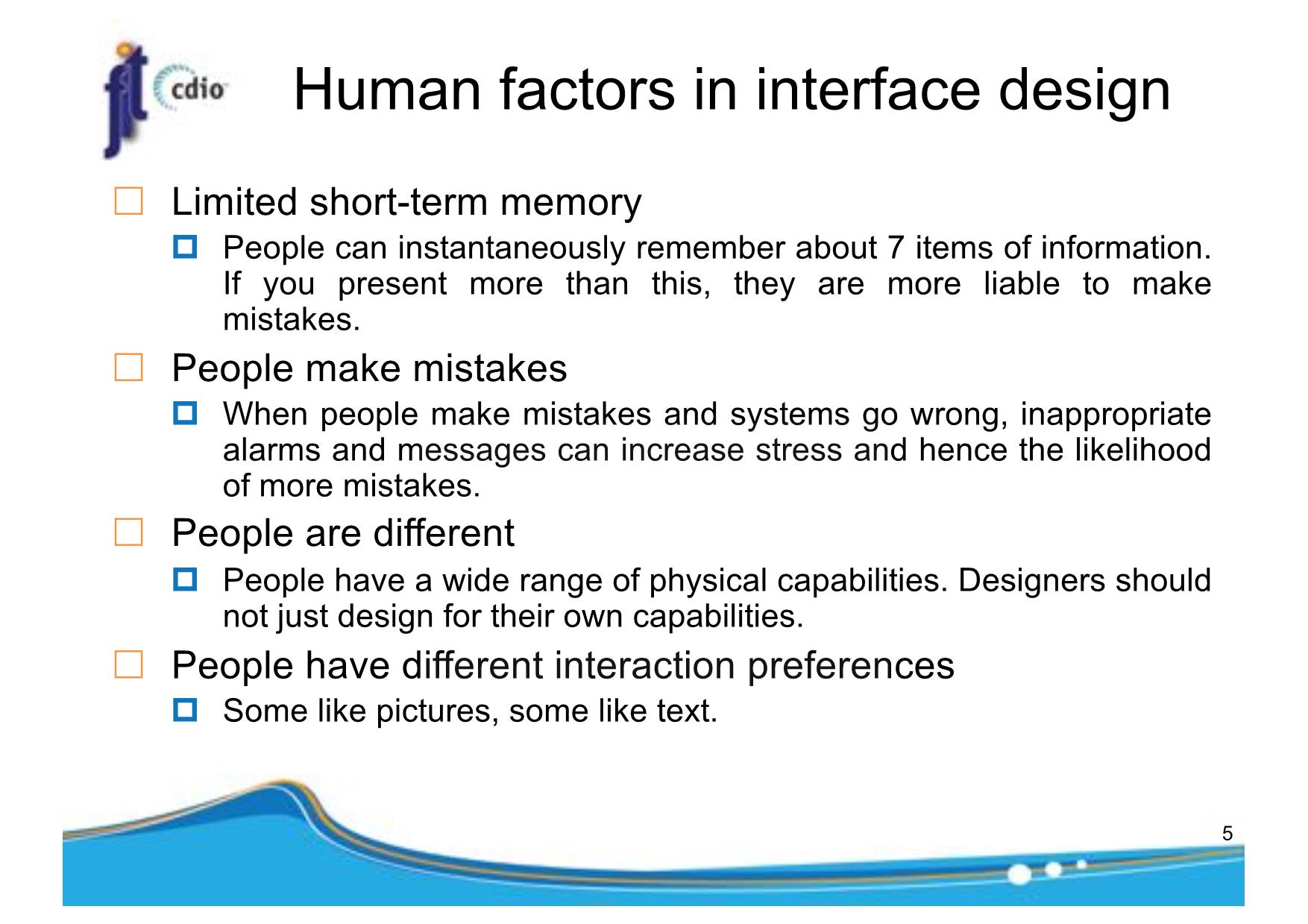
Trang 5

Trang 6
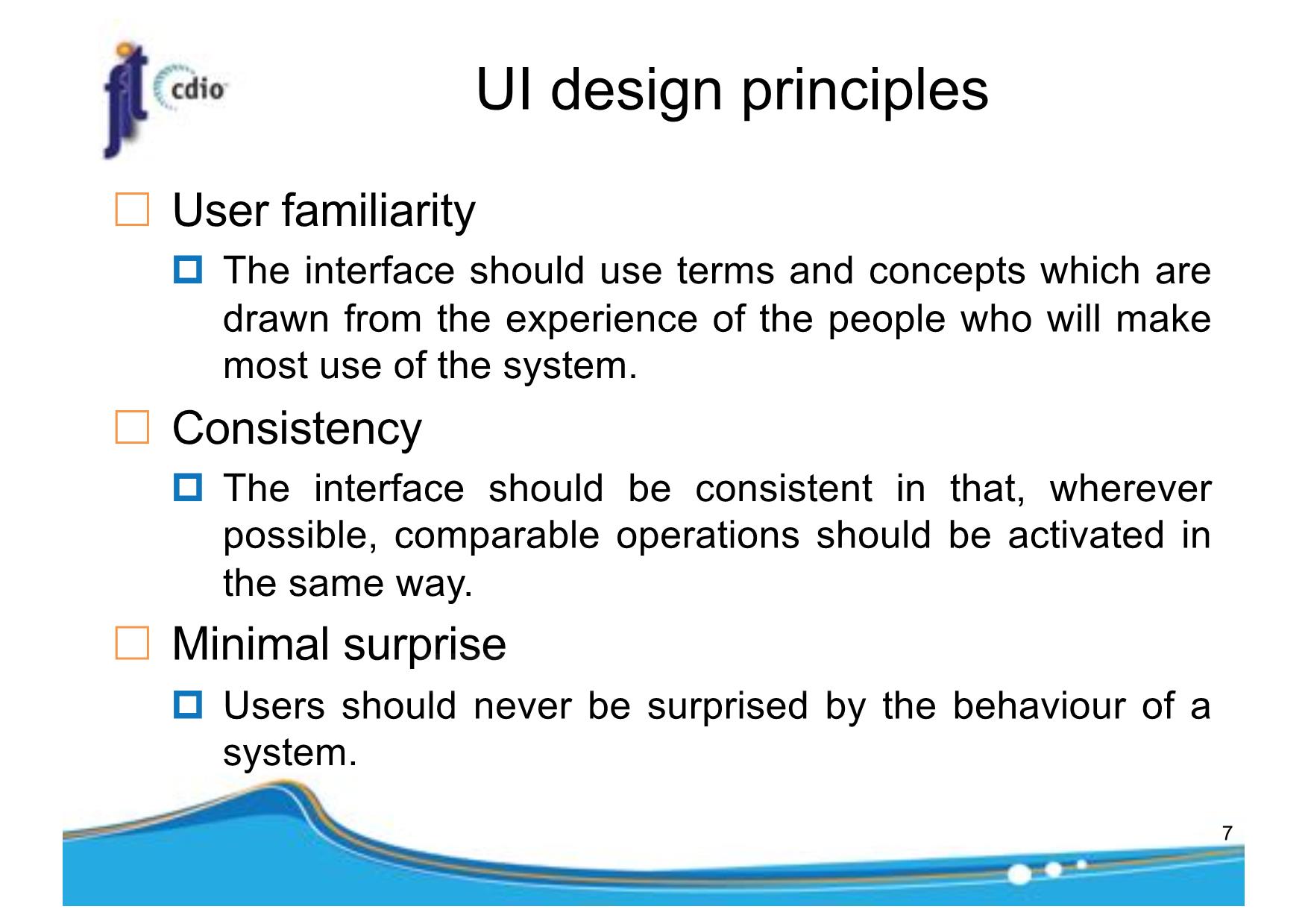
Trang 7
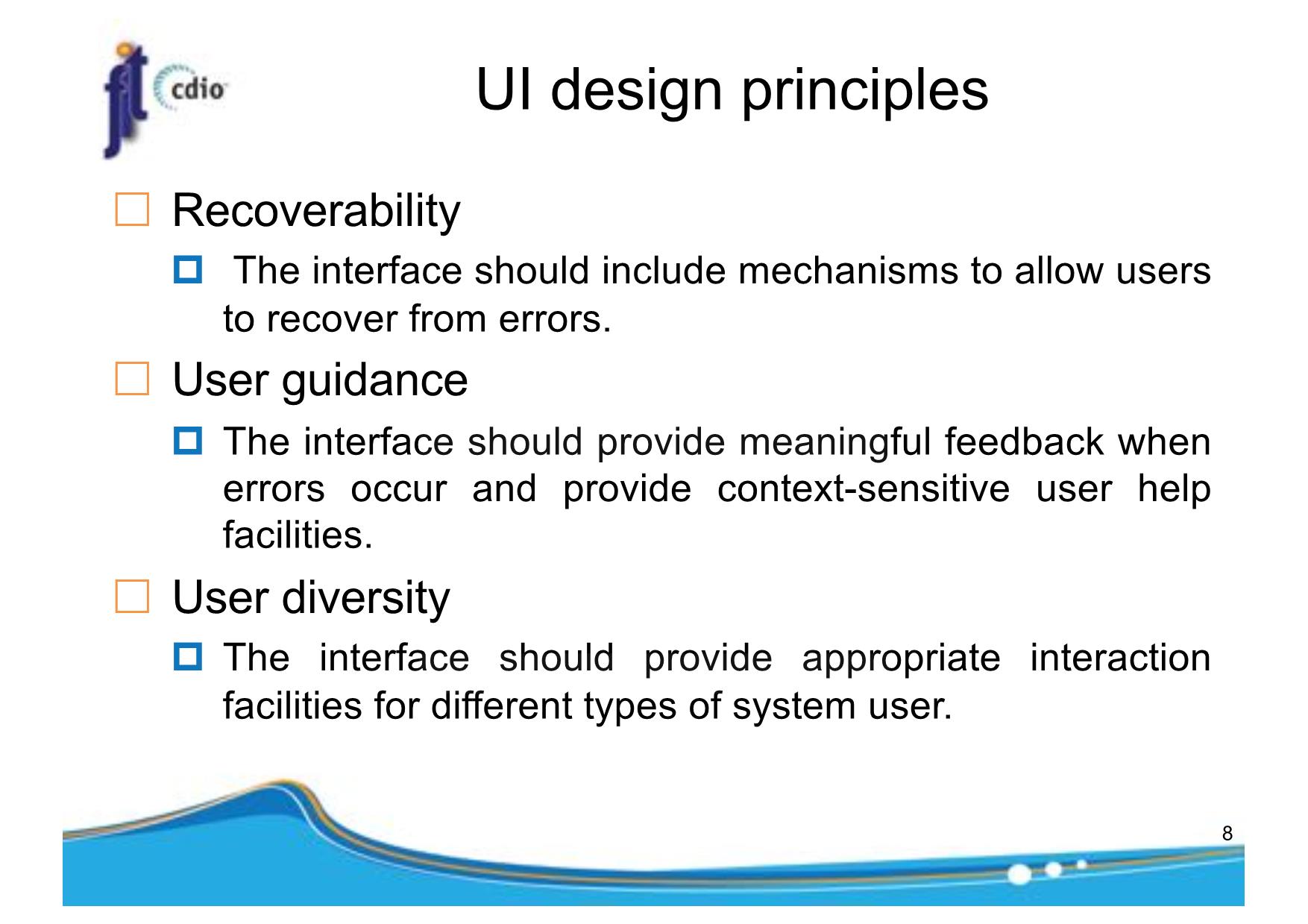
Trang 8
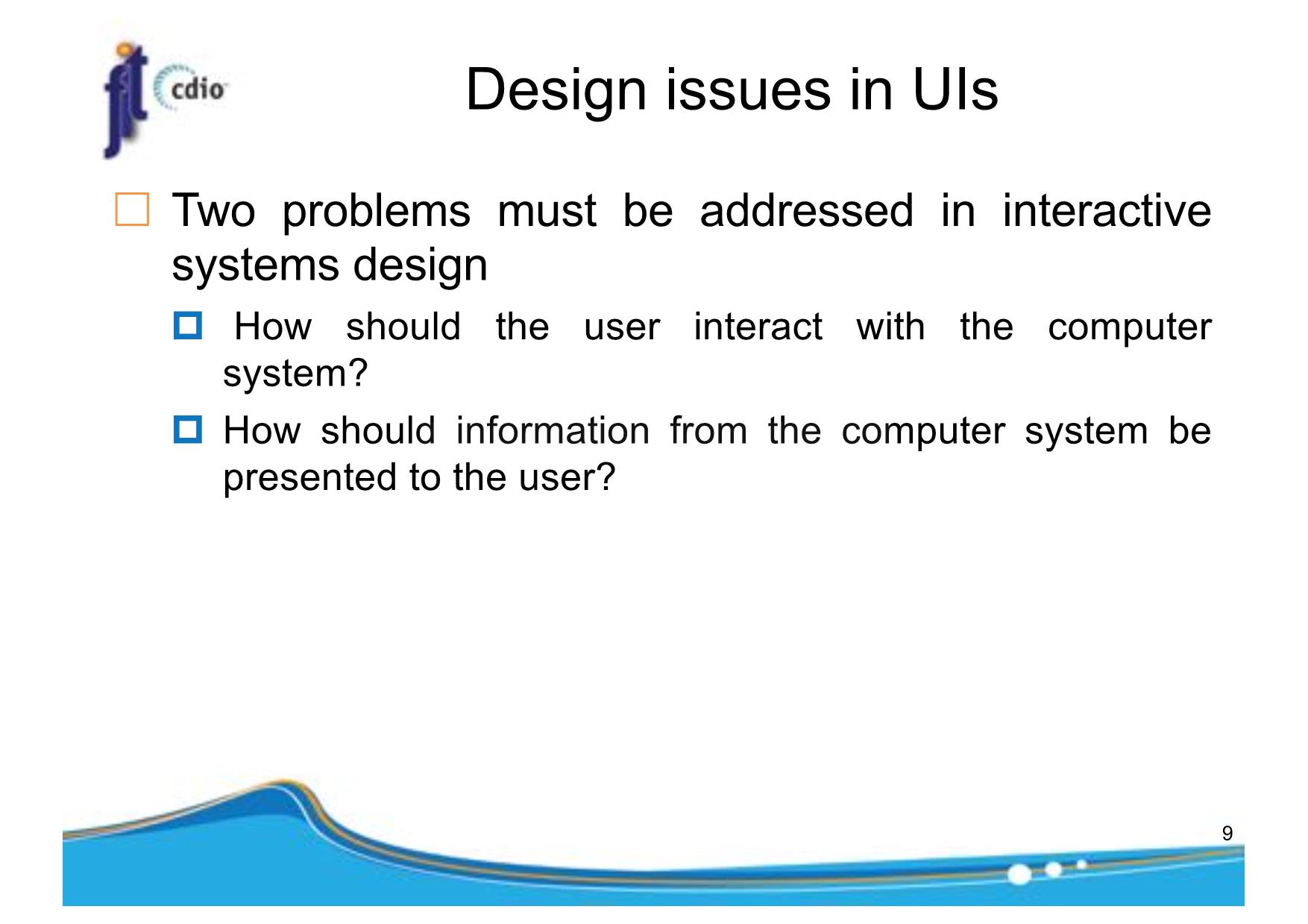
Trang 9
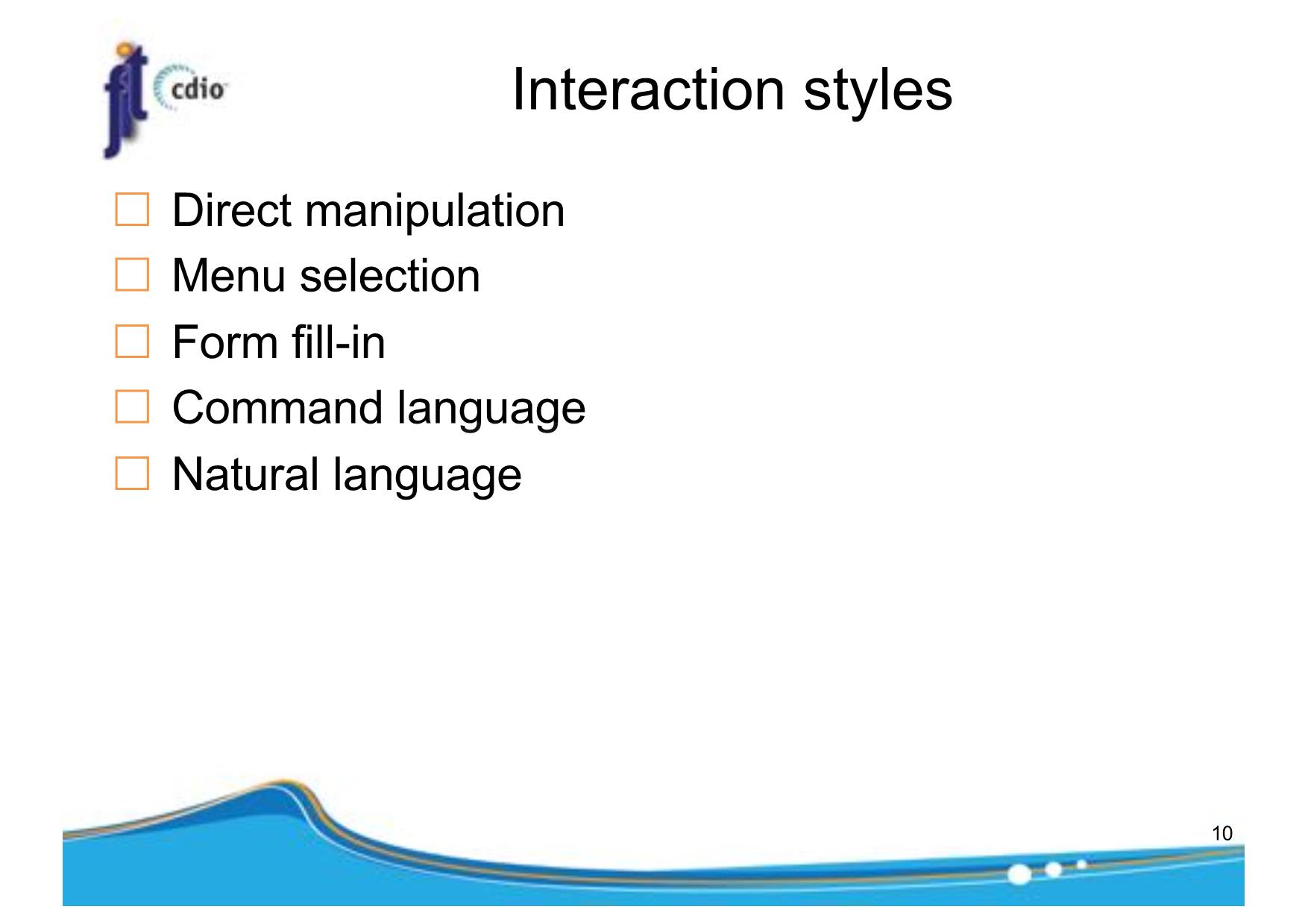
Trang 10
Tải về để xem bản đầy đủ
Bạn đang xem 10 trang mẫu của tài liệu "Bài giảng Introduction to Software Engineering - Week 8: UI Design - Nguyễn Thị Minh Tuyền", để tải tài liệu gốc về máy hãy click vào nút Download ở trên
Tóm tắt nội dung tài liệu: Bài giảng Introduction to Software Engineering - Week 8: UI Design - Nguyễn Thị Minh Tuyền

short-term memory p People can instantaneously remember about 7 items of information. If you present more than this, they are more liable to make mistakes. £ People make mistakes p When people make mistakes and systems go wrong, inappropriate alarms and messages can increase stress and hence the likelihood of more mistakes. £ People are different p People have a wide range of physical capabilities. Designers should not just design for their own capabilities. £ People have different interaction preferences p Some like pictures, some like text. 5 UI design principles £ UI design must take account of the needs, experience and capabilities of the system users. £ Designers should p be aware of peoples physical and mental limitations (e.g. limited short-term memory) and p should recognise that people make mistakes. £ UI design principles underlie interface designs although not all principles are applicable to all designs. 6 UI design principles £ User familiarity p The interface should use terms and concepts which are drawn from the experience of the people who will make most use of the system. £ Consistency p The interface should be consistent in that, wherever possible, comparable operations should be activated in the same way. £ Minimal surprise p Users should never be surprised by the behaviour of a system. 7 UI design principles £ Recoverability p The interface should include mechanisms to allow users to recover from errors. £ User guidance p The interface should provide meaningful feedback when errors occur and provide context-sensitive user help facilities. £ User diversity p The interface should provide appropriate interaction facilities for different types of system user. 8 Design issues in UIs £ Two problems must be addressed in interactive systems design p How should the user interact with the computer system? p How should information from the computer system be presented to the user? 9 Interaction styles £ Direct manipulation £ Menu selection £ Form fill-in £ Command language £ Natural language 10 Interaction styles Interaction Main advantages Main disadvantages Application style examples Direct Fast and intuitive May be hard to implement. Video games manipulation interaction Only suitable where there is a CAD systems Easy to learn visual metaphor for tasks and objects. Menu Avoids user error Slow for experienced users. Most general- selection Little typing required Can become complex if many purpose systems menu options. Form fill-in Simple data entry Takes up a lot of screen space. Stock control, Easy to learn Causes problems where user Personal loan Checkable options do not match the form processing fields. Command Powerful and flexible Hard to learn. Operating systems, language Poor error management. Command and control systems Natural Accessible to casual Requires more typing. Information language users Natural language understanding retrieval systems Easily extended systems are unreliable. 11 Multiple user interfaces 12 Web-based interfaces £ Many web-based systems have interfaces based on web forms. £ Form field can be menus, free text input, radio buttons, etc. 13 Example: LIBSYS system £ Users make a choice of where to search from a menu and type the search phrase into a free text field. £ LIBSYS interaction p Document search: Users need to be able to use the search facilities to find the documents that they need. p Document request: Users request that a document be delivered to their machine or to a server for printing. 14 LIBSYS search form 15 Information presentation £ Is concerned with presenting system information to system users. £ The information may be p presented directly (e.g. text in a word processor) p or transformed in some way for presentation (e.g. in some graphical form). £ The Model-View-Controller approach is a way of supporting multiple presentations of data. 16 Information presentation 17 MVC model of user interaction 18 Information presentation £ Static information p Initialised at the beginning of a session. It does not change during the session. p May be either numeric or textual. £ Dynamic information p Changes during a session and the changes must be communicated to the system user. p May be either numeric or textual. 19 Information display factors £ Is the user interested in precise information or data relationships? £ How quickly do information values change? Must the change be indicated immediately? £ Must the user take some action in response to a change? £ Is there a direct manipulation interface? £ Is the information textual or numeric? Are relative values important? 20 Alternative information presentations • Digital presentation • Compact - takes up little screen space; • Precise values can be communicated. • Analogue presentation • Easier to get an 'at a glance' impression of a value; • Possible to show relative values; • Easier to see exceptional data values. 21 Presentation methods 22 Displaying relative values 23 Data visualisation £ Concerned with techniques for displaying large amounts of information. £ Visualisation can reveal relationships between entities and trends in the data. £ Possible data visualisations are: p Weather information collected from a number of sources; p The state of a telephone network as a linked set of nodes; p Chemical plant visualised by showing pressures and temperatures in a linked set of tanks and pipes; p A model of a molecule displayed in 3 dimensions. 24 Colour displays £ Colour adds an extra dimension to an interface and can help the user understand complex information structures. £ Colour can be used to highlight exceptional events. £ Common mistakes in the use of colour in interface design include: p The use of colour to communicate meaning; p The over-use of colour in the display. 25 Example 26 Colour use guidelines £ Limit the number of colours used and be conservative in their use. £ Use colour change to show a change in system status. £ Use colour coding to support the task that users are trying to perform. £ Use colour coding in a thoughtful and consistent way. £ Be careful about colour pairings. 27 Error messages £ Error message design is critically important. p Poor error messages can mean that a user rejects rather than accepts a system. £ Messages should be polite, concise, consistent and constructive. £ The background and experience of users should be the determining factor in message design. 28 Design factors in message wording Factor Description Context Wherever possible, the messages generated by the system should reflect the current user context. As far as is possible, the system should be aware of what the user is doing and should generate messages that are relevant to their current activity. Experience As u sers become familiar with a s ystem they become irritated by long, ‘meaningful’ messages. However, beginners find it difficult to understand short terse statements of a problem. You should provide both types of message and allow the user to control message conciseness. Skill level Messages should be tailored to the user’s skills as well as their experience. Messages for the different classes of user may be ex pressed in d ifferent ways depending on the terminology that is familiar to the reader. Style Messages should be positive rather than negative. They should use the active rather than the passive mode of address. They should never be insulting or try to be funny. Culture Wherever possible, the designer of messages should be familiar with the culture of the country where the system is sold. There are distinct cultural differences between Europe, Asia and America. A suitable message for one culture might be unacceptable in another. 29 User error £ Assume that a nurse misspells the name of a patient whose records he is trying to retrieve. 30 Good and bad message design 31 Topics covered 1. Design issues 2. User interface design process 3. User analysis 4. User interface prototyping 5. Interface evaluation 32 UI design process £ UI design is an iterative process involving close liaisons between users and designers. £ The 3 core activities in this process are: p User analysis. Understand what the users will do with the system; p System prototyping. Develop a series of prototypes for experiment; p Interface evaluation. Experiment with these prototypes with users. 33 The design process 34 Topics covered 1. Design issues 2. User interface design process 3. User analysis 4. User interface prototyping 5. Interface evaluation 35 User analysis £ If you don’t understand what the users want to do with a system, you have no realistic prospect of designing an effective interface. £ User analyses have to be described in terms that users and other designers can understand. £ Scenarios where you describe typical episodes of use, are one way of describing these analyses. 36 User interaction scenario Jane is a student of Religious Studies and is working on an essay on Indian architecture and how it has been influenced by religious practices. To help her understand this, she would like to access some pictures of details on notable buildings but can’t find anything in her local library. She approaches the subject librarian to discuss her needs and he suggests some search terms that might be used. He also suggests some libraries in New Delhi and London that might have this material so they log on to the library catalogues and do some searching using these terms. They find some source material and place a request for photocopies of the pictures with architectural detail to be posted directly to Jane. 37 Requirements from the scenario £ Users may not be aware of appropriate search terms so need a way of helping them choose terms. £ Users have to be able to select collections to search. £ Users need to be able to carry out searches and request copies of relevant material. 38 Analysis techniques £ Task analysis p Models the steps involved in completing a task. £ Interviewing and questionnaires p Asks the users about the work they do. £ Ethnography p Observes the user at work. 39 Hierarchical task analysis (HTA) 40 Interviewing £ Design semi-structured interviews based on open- ended questions. £ Users can then provide information that they think is essential; not just information that you have thought of collecting. £ Group interviews or focus groups allow users to discuss with each other what they do. 41 Ethnography £ Involves an external observer watching users at work and questioning them in an unscripted way about their work. £ Valuable because many user tasks are intuitive and they find these very difficult to describe and explain. £ Also helps understand the role of social and organisational influences on work. 42 Ethnographic records Air traffic control involves a number of control ‘suites’ where the suites controlling adjacent sectors of airspace are physically located next to each other. Flights in a sector are represented by paper strips that are fitted into wooden racks in an order that reflects their position in the sector. If there are not enough slots in the rack (i.e. when the airspace is very busy), controllers spread the strips out on the desk in front of the rack. When we were observing controllers, we noticed that controllers regularly glanced at the strip racks in the adjacent sector. We pointed this out to them and asked them why they did this. They replied that, if the adjacent controller has strips on their desk, then this meant that they would have a lot of flights entering their sector. They therefore tried to increase the speed of aircraft in the sector to ‘clear space’ for the incoming aircraft. 43 Insights from ethnography £ Controllers had to see all flights in a sector. Therefore, scrolling displays where flights disappeared off the top or bottom of the display should be avoided. £ The interface had to have some way of telling controllers how many flights were in adjacent sectors so that they could plan their workload. 44 Topics covered 1. Design issues 2. User interface design process 3. User analysis 4. User interface prototyping 5. Interface evaluation 45 User interface prototyping £ The aim of prototyping is to allow users to gain direct experience with the interface. £ Without such direct experience, it is impossible to judge the usability of an interface. £ Prototyping may be a two-stage process: p Early in the process, paper prototypes may be used; p The design is then refined and increasingly sophisticated automated prototypes are then developed. 46 Paper prototyping £ Work through scenarios using sketches of the interface. £ Use a storyboard to present a series of interactions with the system. £ Paper prototyping is an effective way of getting user reactions to a design proposal. 47 Prototyping techniques £ Script-driven prototyping p Develop a set of scripts and screens using a tool such as Macromedia Director. When the user interacts with these, the screen changes to the next display. £ Visual programming p Use a language designed for rapid development such as Visual Basic. £ Internet-based prototyping p Use a web browser and associated scripts. 48 Topics covered 1. Design issues 2. User interface design process 3. User analysis 4. User interface prototyping 5. Interface evaluation 49 User interface evaluation £ Some evaluation of a user interface design should be carried out to assess its suitability. £ Full scale evaluation is very expensive and impractical for most systems. £ Ideally, an interface should be evaluated against a usability specification. However, it is rare for such specifications to be produced. 50 Usability attributes Attribute Description Learnability How long does it take a new user to become productive with the system? Speed of operation How well does the system response match the user’s work practice? Robustness How tolerant is the system of user error? Recoverability How good is the system at recovering from user errors? Adaptability How closely is the system tied to a single model of work? 51 Simple evaluation techniques £ Questionnaires for user feedback. £ Video recording of system use and subsequent tape evaluation. £ Instrumentation of code to collect information about facility use and user errors. £ The provision of code in the software to collect on-line user feedback. 52
File đính kèm:
 bai_giang_introduction_to_software_engineering_week_8_ui_des.pdf
bai_giang_introduction_to_software_engineering_week_8_ui_des.pdf

